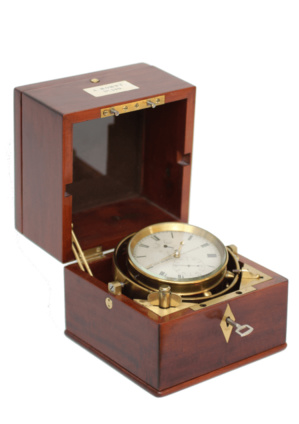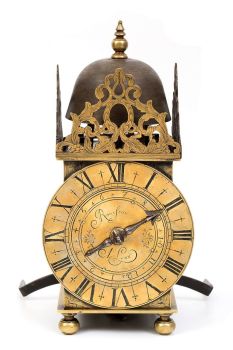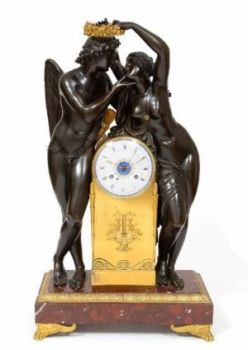A rare Dutch mahogany two-day chronometer by Andreas Hohwü Amsterdam, circa 1865. 1865
Andreas Hohwü
17.50 ⨯ 16.50 ⨯ 16.50 cm
€ 16.500
Gude & Meis Antique clocks and Music Boxes
- Über KunstwerkThe dial
The 8.5-cm engraved silvered dial has Roman numerals and is signed No. 519 ANDr. HOHWÜ AMSTERDAM. There are gold spade hands. Below XII there is the subsidiary for power reserve indication (op/af 0-56) showing how long the chronometer still can run before needing to be wound. This function was vital of course since a stopped chronometer would loose its function for navigation. Above VI is the subsidiary seconds hand.
The movement
The well made movement has spotted plates connected by fine ringed pillars. It has a duration of 56 hours and is being driven by a spring barrel with chain and fusee. To keep the chronometer running while being wound there is Harrison’s maintaining power. The rate is determined by a free sprung compensated balance with helical spring in combination with Earnshaw’s detent escapement.
The case
The movement is housed in an extra brass inner case fixed with bajonet fitting. This is fitted in a brass case with the winding hole at the bottom and that is suspended in brass gimbals. Three-tier mahogany case with brass mounts and a plaque to the front signed A. HOHWÜ No. 519.
Andreas Hohwü
Without a doubt Andreas Hohwü was the best chronometer maker Holland has ever had. He was born in Gravenstein (Sleswig-Holstein) in 1803 as the son of Thomas Hohwü a regular clockmaker. He was apprenticed to his father and showed great promise which enabled him to become a student of the famous chronometer maker Kessels in Altona in 1829. Because of his progress he was allowed to go to work and learn at the famous house of Breguet in 1835 where he worked until 1839. In 1840 he started a business under his own name at the Oudeschans Amsterdam. Besides chronometers he also made many precision regulators that were mostly shipped to observatories all over the world. He designed the propulsion of the coastal light houses. After long study he
designed and patented a secondary compensation for middle temperature error. He was awarded by the government with the ‘Knight in the Order of the Oak Crown’ and ‘Knight in the Order of the Dutch Lion’. Internationally he received the ‘Knight Order of Italy’ and the ‘honorary diploma of Vienna’. He also won awards at internaional exhibitions. Andreas Hohwü died in 1885. Lit.; Enrico Morpurgo, Nederlandse Klokken- en horlogemakers vanaf 1300, pp. 59. - Über KünstlerAndreas Hohwü wurde in Gråsten an der deutsch-dänischen Grenze als Sohn des Uhrmachers Thomas Howhü geboren. Später wurde er Lehrling des berühmten niederländischen Uhrmachers Hendrik Johan Kessels (1781-1849) in Hamburg. Anschließend zog er nach Paris, um für den Uhrmacher Louis Breguet (1804-1883) zu arbeiten, bis er 1840 nach Amsterdam ging, um sich selbstständig zu machen. Er stellte Pendeluhren und Chronometeruhren her und erhielt für seine Werkstattpraktiken zwei niederländische Ehrentitel.
Sind Sie daran interessiert, dieses Kunstwerk zu kaufen?
Artwork details
Kategorie
Related artworks
Artiste Inconnu
Set Franse Empire Pendules / Empire Lectura penduleearly 19th
Prix sur demandeKuipers Kunst & Antiek
1 - 4 / 24- 1 - 4 / 12







































